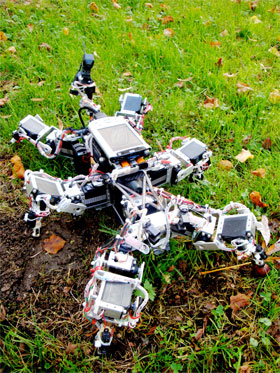
Whether climbing a hill or navigating tricky terrain, a new six-legged robot has got it covered using a digital circuit that mimics specialized brain cells used by insects for walking.
In cockroaches, for example, repetitive movements like breathing or walking are controlled by small clusters of brain cells called central pattern generators, or CPGs.
Some walking machines use digital CPGs, but they require a separate CPG for every gait. For example, a robot would use one pattern generator to climb a slope but must switch to a different one if faced with an obstacle.
"This approach comes with some undesired properties," study team member Marc Timme of the Max-Planck-Institute in Gottingen, Germany, told TechNewsDaily.
For instance, if a robot finds itself in a situation that it doesn't have a CPG for, it doesn't know what to do. Also, learning is more complicated because multiple CPGs are involved.
Creating order out of chaos
In contrast, the hexapod robot – dubbed AMOS for "Advanced Mobility Sensor Driven Walking Device" – can generate different gaits on the fly and can switch between them in a flexible manner using only one simple CPG.
Sign up for the Live Science daily newsletter now
Get the world’s most fascinating discoveries delivered straight to your inbox.
AMOS does this by harnessing the jerky, disorderly movements of its legs. Its single CPG uses sensory inputs from each of its six legs to create repetitive movements that can be used to determine an appropriate gait.
The process is similar to how humans manage to remain upright while riding a bike, Timme said.
"You control unstable sideways motion using small motions that you exert onto the bike," he explained. "The 'upright-driving' position exists but it's unstable … [but] if you are close to upright, [you can use] very small forces suffice to stablize the unstable state."
AMOS uses its sensory inputs and its CPG to effectively find the few periodic patterns amid its chaotic leg movements and then creates other movements that help to maximize their effects.
A robot that learns
The end result is a robot that can learn to adapt to its environment. For example, if AMOS is climbing a slope for the first time, sensors on its legs might show that its current gait is consuming too much energy.
The robot's CPG will then kick into gear and cycle through different gaits until an appropriate one is found that saps less energy. If the robot tries to climb the hill a second time, it will immediately adopt the correct gait.
In the future, AMOS will be equipped with a memory device that will enable it to complete movements even without any sensory input from its legs.
In order to walk over an obstacle, for instance, the robot would have to take a large step with each of its six legs.
"Currently, the robot would not be able to handle this task," Timme said. "As soon as the obstacle is out of sight, it no longer knows which gait to use. Once the robot is equipped with a motor memory, it will be capable [of using] foresight and plan its movements."
The research is detailed in the current issue of the journal Nature Physics.
- Gallery: Cutting-Edge Robots
- Future Robots Will Run Like Cockroaches
- World's Smallest Hot Rod Made Using Nanotechnology









